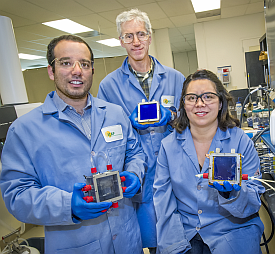
L to R: Miguel Modestino, Joel Ager, and Rachel Segalman (Roy Kaltschmidt, Lawrence Berkeley National Lab)
Researchers at Lawrence Berkeley National Laboratory in California developed a device to test on a small scale electrochemical solar-energy conversion methods for future fuel cell and artificial photosynthesis technologies. The team led by Joel Ager and Rachel Segalman from the Berkeley Lab’s materials science division and Joint Center for Artificial Photosynthesis published its findings in a recent issue of the journal Physical Chemistry Chemical Physics (paid subscription required).
The team devised a microfluidic — lab-on-a-chip — devised that simulates artificial photosynthesis processes, and allows for testing different materials acting as cathodes and anodes for power generation. Artificial photosynthesis is considered a promising solar technology, if the natural photosynthesis process can be enhanced to more efficiently produce hydrogen- or hydrocarbon- based fuels.
The microfluidic test system developed by the Berkeley Lab team allows for the independent testing of various materials as cathodes or anodes, with charge carriers transported through an ion-conducting polymer membrane. One of the missions of the lab’s Joint Center for Artificial Photosynthesis is to develop artificial synthesis with nano-engineered membranes that boost the productivity of photosynthetic cells.
In the publication, the system was tested on electrolysis of water, where the chemically inert membrane separates the anode and cathode, as well as the channels that generate hydrogen and oxygen from the splitting of water molecules. The authors say the device can be adapted to test a wide range of materials and processes for use in future electrochemical systems, such as fuel cells.
Lead author Miguel Modestino says the microfluidic chip is small in size and is relatively easy to make, as well as customize in dimensions and materials depending on the objectives of the tests. The authors say almost any photo-electrochemical material, including components made of earth-abundant elements, can be tested with the device.
Read more:
- New Type Battery Designed for Solar, Wind Grid Storage
- Enzyme Cocktail Generates High Volume Hydrogen from Biomass
- Solar Nanoscale Protein Filter Cleans Antibiotics from Water
- NSF Funding Organic Crystals Research for Electronics
- Renewable Power Storage, Management Modules in Development
* * *

 RSS - Posts
RSS - Posts
You must be logged in to post a comment.